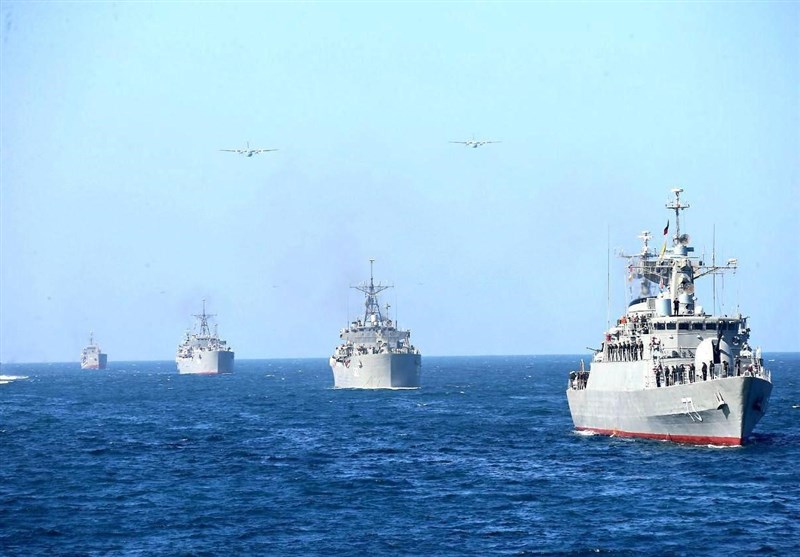The Iranian military concluded large-scale military exercises in the southern and southeastern parts of the country on Wednesday, where it tested new domestic-made missiles.
On Monday, the Army’s Ground Force, Air Force, Navy and Air Defense began massive joint drills and wargames, codenamed Muhammad Rasoulallah-5 (meaning “Muhammad, the Messenger of God”), to test their respective combat skills and military tactics. The drills covered an area of 220,000 square kilometers (85,000 square miles) in Iran’s southern and southeastern regions, the Sea of Oman, and near the Makran Coast, according to reports by Tasnim news agency.
During the drills Iran’s navy used light and heavy submarines, helicopters and reconnaissance planes, and for the first time tested the home-made, long-range, deep sea Qadir (“Almighty”) cruise missile. Qadir is a new generation of cruise missiles capable of destroying marine targets with high precision and power, and can be fired from off the coast or marine vessels. The missile’s range is up to 300 kilometers (186 miles).
Combined sonic and magnetic demining operations were carried out using naval helicopters, and the Air Defense units tested systems that were reported to be successful in destroying enemy planes, drones and cruise missiles, at low, mid and high altitudes.
Iran’s short-range Naze'at, Fajr-5 and Nasr rockets, along with medium- and long-range surface-to-surface missiles, 155-mm laser-guided cannon balls, and automatic 122-mm cannon balls, were all fired during the drills, according to Fars news agency. Azarakhsh and Shahab rocket-launching boats detonated a hypothetical enemy’s vessels, and Ra’ad assault vessels were used for a minelaying operation.
On Wednesday, in an interview with Mehr news agency, the Iranian president’s Military Aide and a former Defense Minister Brigadier General Hossein Dehqan underlined Iran’s capabilities in missile production.
“Despite the fact that we have the capability to develop missiles in different ranges, with high destruction and precision power, we have kept the range of our missiles appropriate to possible threats,” Dehqan said.
On the same day, the Deputy Chief of Staff and Spokesman for Iran's Armed Forces Brigadier General Massoud Jazzayeri dismissed the possibility of holding talks with western states about the country's missile program.
“Discussions about defense and missile affairs, and the resistance in the region with the regimes which have repeatedly proved their autocracy and colonialism, is nothing but delirium,” Jazzayeri said, according to Tasnim.
The exercises were briefly disrupted on Monday when two American warships were said to have approached Iran’s drills area, during early hours of the exercises, supposedly to observe the Iranian navy units.
"After raising the issue to the tactical base used during the drills, patrolling and reconnaissance planes flew over coalition warships and warned them [to leave the region], and the warships left the drills zone," said drills spokesman Rear Admiral Seyyed Mahmoud Moussavi.
American military officials confirmed being in contact with Iran’s forces.
Lieutenant Chloe Morgan, a spokeswoman for the U.S. Navy’s 5th Fleet in Bahrain, said that the U.S. Navy received only a radio message from Iranian naval vessels about an ongoing Iranian exercise in the Strait of Hormuz, however, dismissing Tehran’s claims of a tense encounter between the two fleets.
Cmdr. William Urban, a spokesman for U.S. Naval Forces Central Command, said the American military vessel that received the transmission continued to carry out its mission despite the Iranian contact and did not alter its course.
"The U.S. warship continued to execute its mission and did not alter operations as a result of the radio transmission," Urban told the Free Beacon. "U.S. warships continue to sail and operate wherever international law allows."
Escalations between American and Iranian forces in the Gulf are not common, but not unheard of.
Last July, a U.S. Navy ship fired warning shots when an Iranian vessel approached it within 450 feet (137 meters). The following month, an unarmed Iranian drone came within 100 feet (30.5 meters) of a U.S. Navy warplane as it prepared to land on an aircraft carrier in the Gulf.
During the U.S. presidential race in 2016, then-candidate Donald Trump vowed that any Iranian vessel that harasses the U.S. Navy in the Gulf would be “shot out of the water.”







 Azerbaijan and Armenia started the process of demarcation of their border on Tuesday, with the installation of the first border markers based on ge...
Azerbaijan and Armenia started the process of demarcation of their border on Tuesday, with the installation of the first border markers based on ge...
 President Aliyev emphasized the critical role of the North-South Transport Corridor in fostering transport cooperation between Azerbaijan and Russi...
President Aliyev emphasized the critical role of the North-South Transport Corridor in fostering transport cooperation between Azerbaijan and Russi...
 Armenian sappers commenced on Monday mine-clearance operations in the territories adjacent to the Saint Mary Church in village of Voskepar (Armenia...
Armenian sappers commenced on Monday mine-clearance operations in the territories adjacent to the Saint Mary Church in village of Voskepar (Armenia...
 Russian Foreign Minister Sergei Lavrov has reasserted that Moscow has no intentions to stop the fighting in Ukraine, even if peace talks commence.
Russian Foreign Minister Sergei Lavrov has reasserted that Moscow has no intentions to stop the fighting in Ukraine, even if peace talks commence.



